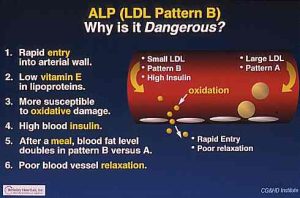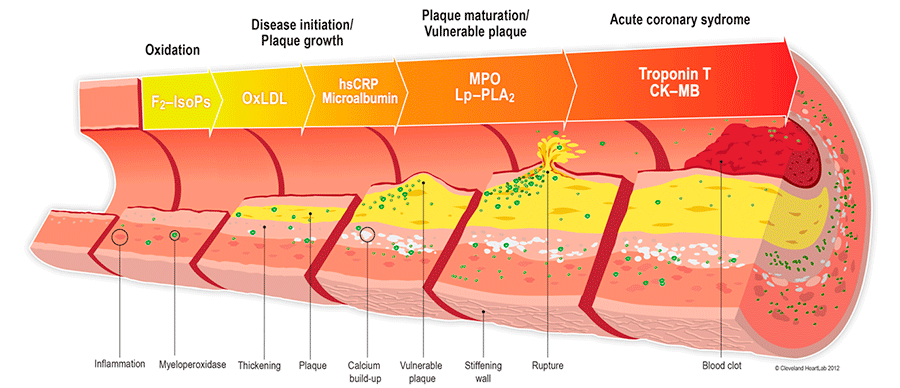Cardiovascular Risk in Depth
Is Cholesterol the Culprit?
Cardiovascular risk biomarkers in great detail. Heart disease is an inflammatory process. Cholesterol does not cause heart disease. That may seem a new notion. It is not. Rudolph Virchow so long ago postulated that heart disease and cancer were inflammatory processes.
In the pathogenesis of inflammation, Virchow highlighted the importance of the inflammatory stimulus. The irritatio is the starting point and the conditio sine qua non . Through his pathohistological investigations in experimental animals and in humans, inflammation was widely accepted as the central cause of atherosclerosis, until the end of the 19th century, and has been confirmed in recent decades.
We now look at a more complex picture of cholesterol and lipids (fats or triglycerides), and newer risk factors, in the blood. This gives you a give a more sophisticated and predictive picture of your cardiovascular health or risk:
- Cholesterol– is a participant, not the cause of cardiovascular disease.
- HDL – the [good] lipoprotein that carries cholesterol away from the heart back to the liver. The higher the more protective.
- ApoA — a liver marker for HDL
- LDL – the [bad] lipoprotein that carries cholesterol to the heart from the liver. The lower the better.
- ApoB — a liver marker for LDL
- Triglycerides – neutral fats, elevated by increased carbohydrate intake, which has its own risk consequence.
- LDL particle sizing – small heavy dense vs large fluffy particles. This has lead to a new risk profile type called Pattern B or Pattern A. (see below)
- LDL and HDL isoforms – both can be fractionated into five separate and more distinct components.
The New 21st Century Risk factor profile
- Lp(a) – (lipoprotein a) – a degenerative form of the LDL that aggressively promotes atherosclerosis (hardening of the arteries).
- Homocysteine – newer risk factor — from incomplete conversion of the amino acid homocysteine to methionine that may be irritating to blood vessels. This inflammatory response is a risk for vascular disease.
- hsCRP – high sensitivity C-Reactive Protein – a sensitive, but non-specific, measure of inflammation — showing newer notions of cardiovascular disease as inflammatory in nature. This is much closer to revealing the cause of cardiovascular disease. Remember, cholesterol does not cause heart or vascular disease.
- Fibrinogen Levels – as above, the higher the fibrinogen levels the greater likelihood of forming small blood clots that can lead to blocked arteries. Blocked arteries can eventually cause strokes and heart attacks. This may have the most prognostic significance (predictor) of any of above and is least likely to be tested by routine or even “advanced” workups
- Lp-PLA2 – (lipoprotein-associated phospholipase A2) – levels — the newest and most sophisticated measurement of the effects of this enzyme. Oxidized LDL causes an entire cascade that leads to atherosclerotic changes. This is reputed to be one of the first markers for cerebrovascular (stroke) risk and a surrogate for endothelial dysfunction. This is an important pathway to heart disease.
- TMAO — trimethylamine N-oxide — the quaternary ammonium nutrients phosphatidylcholine (lecithin), choline, and L-carnitine are readily found in animal-derived products such as red meat, egg yolk and full-fat dairy products. These biochemical nutrients release specific metabolites such as TMA (trimethylamine) into the blood. TMA is then metabolized and converted in the liver into TMAO (trimethylamine N-oxide). These metabolites participate in the development of atherosclerosis.
LDL and HDL Particle Sizing
Look above at LDL particle sizing. There is an increasingly recognized, but infrequently and poorly diagnosed syndrome of high triglycerides and low HDL which is a surrogate marker for these small dense LDL particles. Termed Pattern B or ALP (Atherogenic Lipoprotein). Look at the following illustration. See how these small dense particles “leak” into the vascular wall and the larger LDL particles don’t?
This leak is the beginning of atherogenesis, or atherosclerosis — hardening of the arteries. The end result: high blood pressure and blocked arteries eventually leading to strokes and heart attacks.

fig 2 — Atherogenic Lipoprotein Picture
Why is this important? Because routine testing will not measure any of this. A Normal LDL level might actually be quite dangerous. You need to go to more sophisticated testing and understanding.
This what we here at the Institute offer you — a more complete look at these very complex issues. And better answers to why you may have problems with difficult to treat hypertension or heart disease.
Conclusion
So the story is a lot more than just Cholesterol. Cells need a certain amount of cholesterol as a lubricant for healthy cell membranes. It is also the biochemical source of all sex, stress and blood pressure regulating steroids — so that it can’t be all bad.
In fact, some studies have that very low cholesterol levels in men can increase risk of death.
Bottom line: you need the resources and expertise of physicians who fully understand the more complex story of lipids and who have access to more advanced testing methods.
We offer one of the most sophisticated, and non-invasive approaches to cardio-vascular problems available anywhere — from the comprehensive testing as explained above to a combination of the following modalities:
- Resting EKG — basics
- ECHOcardiogram for ejection fraction — dynamics
- Dual Isotope HeartScan — regional flow
- Treadmill Stress Testing with Met equivalent — exercise tolerance
- Carotid Ultrasound or CIMT (intimal media thickness) scans — on site and in office testing
- Superfast CT (EBT) HeartScans for coronary artery calcifications
Clinical Lab Resources
We are excited to serve as a regional lipid disorder center following many of the guidelines of the American Heart Association and in conjunction with one of the best and most accurate labs in the country – originally Berkeley HeartLabs [now Quest Diagnostics Cardio IQ testing]. BHL was founded and promoted by Dr. Robert Superko [beyond LDL]. They were in the vanguard of lipid analysis and newer thinking. They were superseded by more automated, and cost effective, VAP testing by Atherotech which approximated the gold standard BHL testing.
In this ever evolving and now consolidating field of study Cleveland HeartLab with Quest Diagnostics offers the most comprehensive and cutting edge array of tests for cardiovascular lipid and inflammatory biomarkers. Total cardio-metabolic profiling.
More advanced testing is coming of age based on the notion that cardiovascular disease is a complex series of inflammatory processes, not simply an accumulation of cholesterol. From Cleveland HeartLab we are now able to measure oxidized LDL. This is revolutionary!

fig 3 — continuum of intimal disease
Using our sophisticated approach, we at the California Age Management Institute can take this to a new dimension of dietary modification along with intensive, targeted and known vitamin co-factors, selected minerals, anti-oxidants and phytonutrients.
We are the only center in the entire Bay Area offering CIMT (carotid intimal media thickness) with early plaque detection. We have the additional ability to process full color doppler flow studies, looking for early treatable disease and endothelial dysfunction, not late stage disease.
That’s a lot of information. This requires time and a thorough analysis and explanation. It is our special offering — patient education and empowerment.
Want to know your current risk profile and how to prevent major cardiovascular events — heart attacks and strokes?
Call us today for your first consultation. The life you save could be your own.